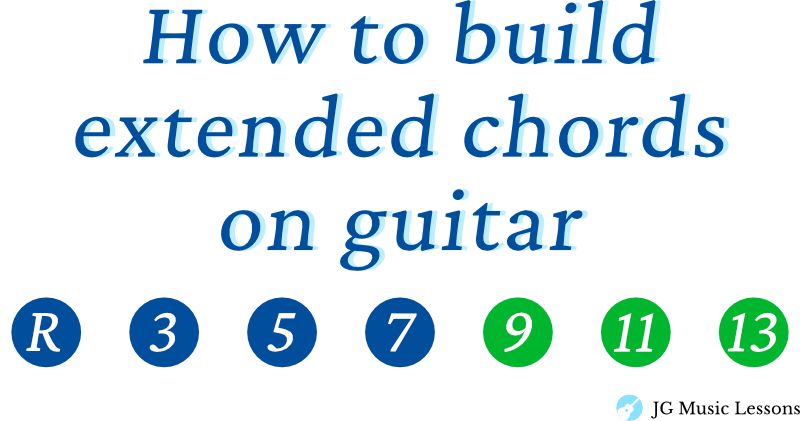If you know your basic chords, it’s helpful to learn to build extended chords to give you more flexibility and depth on the guitar. This skill will help you to create new chords and enhance your chord progressions.
I recommend reviewing ways of playing different chords such as Major, minor, and 7th chords if you’re not confident with those yet.
In this guide, you’ll learn how to add notes to your guitar chords to make them sound fuller. Let’s get start right away!
What are extended chords?
Extended chords are any chord that include notes beyond the basic triad structure of a chord.
For example, a C Major chord has the notes C, E, and G which are the 1st, 3rd, and 5th degrees. If we extend past those notes and add the 7th degree, we get a C Major 7 with the notes C, E, G, and B.
We can keep adding notes beyond the 7th chord structure to build even more extended chords such as adding the 9th, 11th , and 13th degree.
These harmonically rich extended chords are also commonly referred to as jazz chords. You can check out this guide to learn how to play jazz chords on guitar.
Building extended chords – Getting started
A great to build extended chords is by starting with the 1st, 3rd, and 7th degrees of the chord, also known as shell chords.
Shell chords are great to know because they outline important notes in a chord. These chords use the root note, the 3rd tells us whether the chord has a Major or minor quality, and the 7th which tells us whether it’s a Major 7, Dominant 7, or minor 7 quality.
These highlighted notes are also referred to as the chord tones, which change depending on the chord quality.
Shell chord examples
Before we build upon these types of chords, here are 3 examples of shell chords. The chord tones will be written to the right of the chord charts.

If you don’t know these already, see how to play shell chords on guitar.
Finding extended notes above shell chords
Once you have the shell chords down, you can simply look for available notes above the structure. Here are the same chords as the previous section with added extended notes.

This is just one variation of adding an extended note to the chord. As a side note, you may hear these notes referred to as extended chord tones.
Extended chord examples
Now that you have an idea of how this concept works, let’s explore more possibilities for adding extended notes starting on different strings.
The following examples are movable shapes that can be shifted to any root note on the string mentioned.
Major 7 extended chords on the 6th string

Major 7 extended chords on the 5th string
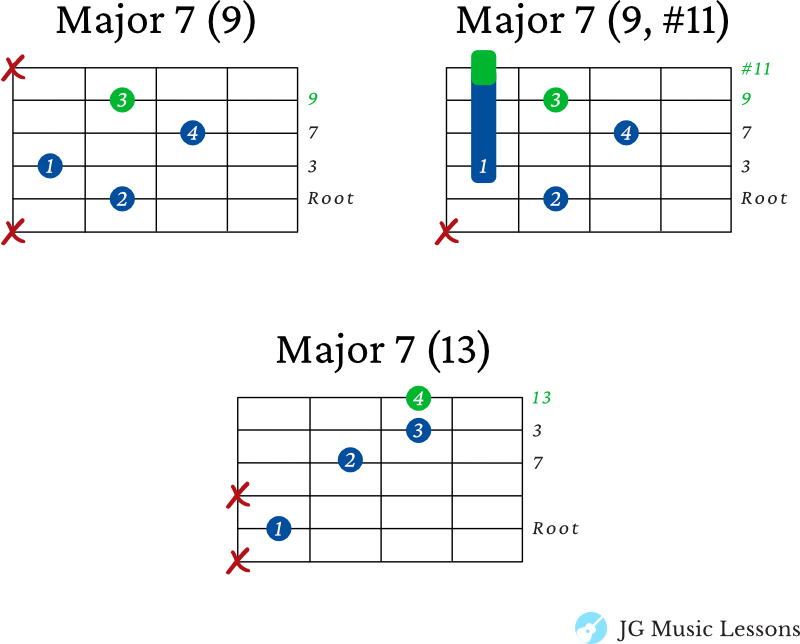
Dominant 7 extended chords on the 6th string
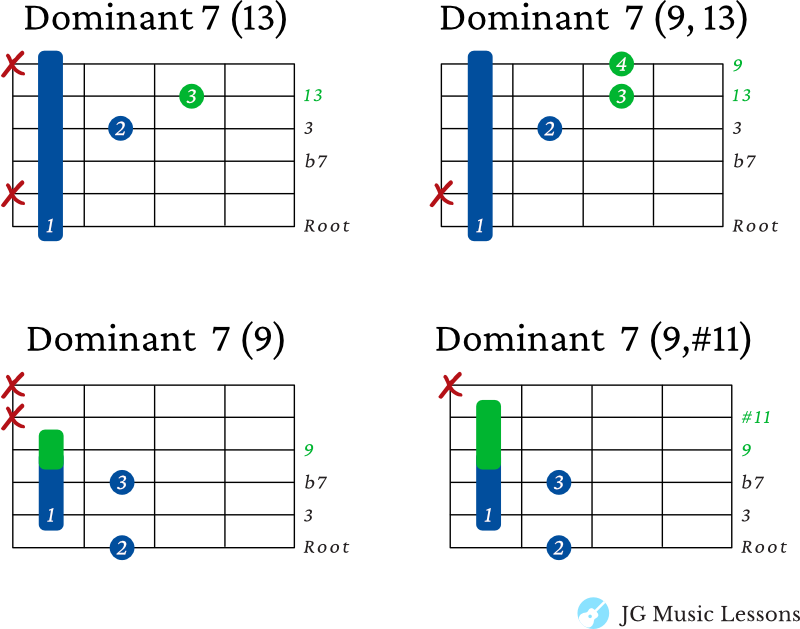
There are many other chord variations possible for Dominant 7 chords you can try such as:
- Dominant 7 (9, 13)
- Dominant 7 (b9, 13)
- Dominant 7 (#9, 13)
Or also:
- Dominant 7 (9, b13)
- Dominant 7 (b9, b13)
- Dominant 7 (#9, b13)
Dominant 7 extended chords on the 5th string


minor 7 extended chords on the 6th string
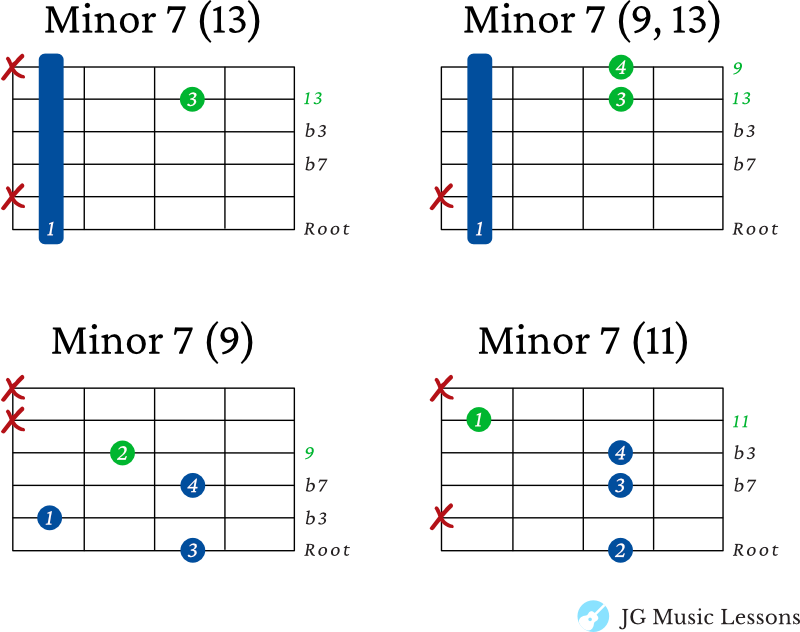
minor 7 extended chords on the 5th string
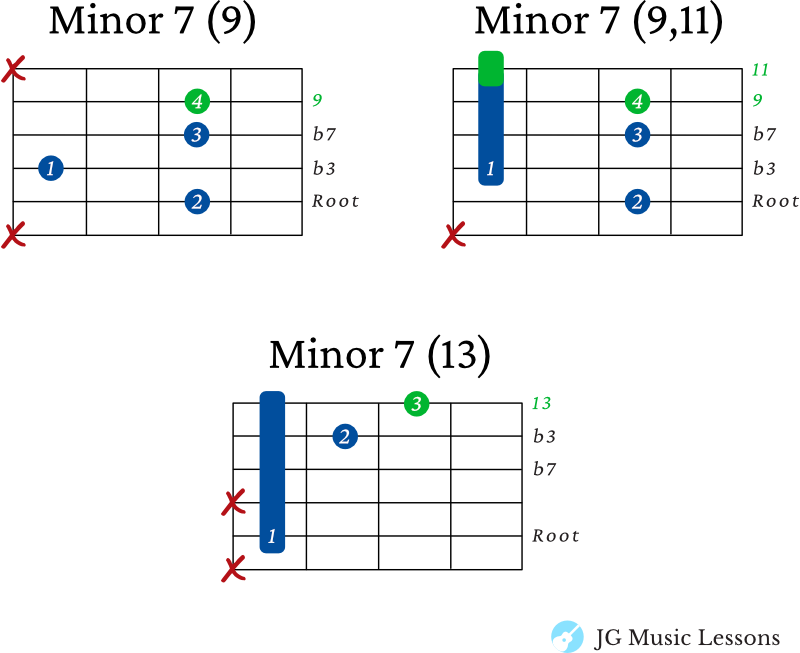
These are just some examples over 3 chord qualities but you can also try this with other chords you already know. On some chords, you can replace 3rd with 9th chord tones for more variations.
You can also try changing 7th with 6th chord tones which can labeled as different chords such as Major 6 or minor 6 chords.
If you want a more in-depth look at these extended chords, I suggested checking out the guide on jazz chords.
Wrapping Up
As you learned in this post, building extended chords on guitar is not as complicated as it seems. You can take the chords you already know and look for new notes that act as extensions to the basic structure.
I hope this guide helps you to explore extended chords to add more depth to your playing. As you add new chords to your tool belt, you’ll have more possibilities when composing your own music.
Want to learn more interesting concepts related to chords? Check out this other lesson on how to play drop 2 chords on guitar.
📘 Get the free guitar practice guide here!
All the best,
JG Music Lessons
Start Playing Better, Faster
with Pro Membership! ✨
Get the guidance, tools, and support that keep your progress on track:
🏁 Always know what to practice next. Access the full Guitar Learning Roadmap with lessons in sequence.
🎼 Play songs with confidence. Step-by-step lessons of popular, classical pieces and other styles.
📙 Save time and frustration. Clear PDFs and ebooks that save time so you can focus on playing.
🎟️ Get rewarded for consistency. 2 free downloads every month (a $240+ yearly value).
🎁 Keep costs low while you grow. 50% off all charts, tracks, and posters — up to 75% off bundles.
🚫 Stay focused. Ad-free environment keeps you in the zone.
💬 Get help when you need it. Direct member support to keep you on track.

